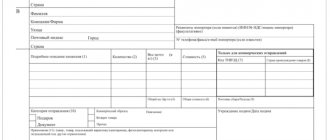Adjustment of previous periods in 1C: basic parameters
The machine gives you the opportunity to simply adjust whatever you need. Adjustment of previous periods in 1C depends primarily on how the error affected the tax paid and there are two possible scenarios:
- When the tax amount is not underestimated, this period is subject to correction.
- Otherwise, if the tax amount is underestimated, the closed period will have to be corrected.
The last scenario will oblige the accountant to do manual accounting entries.
How to correct a receipt in a closed period
It is always easier to study any question that concerns you with examples. That's what we'll do. Let's say the company made a mistake and overstated its expenses due to a technical glitch. Received services from external suppliers were registered using the receipt option (acts, invoices) from the purchase section. At the same time, the accountant registered the invoice:
The supplier issued an invoice for its services, the VAT amount was accepted for deduction.
For the accepted services, the accountant created a corrective document for adjustment of receipts. The important point is to understand and identify the reason why the accounting data was adjusted. I decided to present the reasons in the form of a table.
| No. | Type of action | Description |
| 1 | Primary correction | What is listed in your accounting and what is indicated in the incoming primary statement may not coincide. The supplier himself may simply make a mistake by incorrectly indicating the item in the invoice |
| 2 | Correcting your mistake | You received the correct primary product, but you made a mistake yourself or there was a technical failure, but it’s already in your company and the counterparty has nothing to do with it |
Adjustment of receipts of the previous period
Let's look at an example.
Let’s say that the Confetprom company discovered a technical error in March when providing communication services for December 2015; the amount of costs was exceeded by 30,600 rubles.
The receipt of communication services in 1C 8.3 was documented with the document Receipt (acts, invoices) from the Purchases section. An invoice was also immediately registered:
An invoice was also issued:
and VAT was accepted for deduction:
A corrective document, Receipt Adjustment, was issued for this receipt.
It is important to determine the reason for the adjustment (type of operation):
- Correcting your own error - if a technical error is made, but the primary documents are correct.
- Correction of primary documents - if the conformity of goods/services and other things does not coincide with the primary documents, there is a technical error in the supplier’s documents.
Let's look at this example in these two situations.
Own mistake
In this case, a technical error was made in the amount by the accountant, so we select Correct our own error:
When editing a document from a previous period, in the Item of other income and expenses field, Corrective entries for transactions of previous years are set. This is an income/expense item with the item type Profit (loss) of previous years:
On the Services tab, enter new data:
When posting, the document generates reversal entries downward if the final amount is less than the corrected amount. And additional transactions for the missing amount in the opposite situation:
In addition, when adjusting the previous period in 1C 8.3, adjustment entries for profit (loss) are created:
The Purchase Book displays the adjusted VAT amount:
After correcting the previous period in 1C 8.3, it is necessary to make a Reformation of the balance sheet for the last year in the Operations section - Closing the month in December.
How to correct a mistake if you forgot to enter an invoice, how to take into account “forgotten” unaccounted documents in terms of tax accounting when calculating income tax in 1C 8.3, read our article.
Technical error in supplier documents
If a mistake is made by the supplier, Type of operation is set to Correction in the primary documents. We indicate the correction number for both the receipt and the invoice:
On the Services tab, indicate the correct values:
The document makes similar entries with the correction of its own error in adjusting the previous period. You can also print the corrected printed documents.
Bill of lading:
Invoice:
To reflect the corrected invoice in the Purchase Book, you need to create the document Generating Purchase Book Entries from the Operations section by selecting Regular VAT transactions:
In addition to the main sheet in the Purchase Book:
The correction is also reflected in the additional sheet:
How to fix the error
Let's consider a situation where the user mistakenly deposited an incorrect amount and for this you will need to use the command to correct your own error. When it is still necessary to correct a closed period, refer to the item of other income and expenses and mark here the line of corrective entries for transactions of previous years. This applies to an income/expense item with the item type profit (loss) of previous years. The services field requires entering new correct information.
After you finish posting the option, the machine will reverse it downwards in a situation where the final amount is less than the corrected amount. And additional wiring for lack of funds in the opposite situation. Then the machine will independently generate profit or loss entries. As a result of the actions taken, the corrected VAT will be reflected in the Purchase Book.
After you have resorted to the closed period adjustment command, you must perform a Reformation of last year’s balance sheet. To do this, in the transactions section, go to month closing in December.
The procedure for correcting errors of previous years in accounting
In accordance with clause 18 of Instruction No. 157n, additional accounting records for correcting errors, as well as correcting errors using the “Red Reversal” method, are subject to registration with a primary accounting document - a Certificate, which must reflect information on the rationale for making corrections: the name of the accounting register being corrected (Journal transactions), its number (if available), as well as the period for which it was compiled and the period in which errors were identified.
The identified error of the previous year (years) in accordance with the provisions of clause 17 of the Methodological Recommendations is reflected by making entries on the date the error was discovered using special accounting accounts.
The key innovation is the requirement to separate operations related to the correction of errors of previous years identified in the reporting period. A number of special accounting accounts have been introduced into the Unified Chart of Accounts (Order of the Ministry of Finance of the Russian Federation dated March 31, 2018 No. 64n):
- 401 18 “Income of the financial year preceding the reporting year”
- 401 19 “Income of previous financial years”
- 401 28 “Expenses of the financial year preceding the reporting year”
- 401 29 “Expenditures of previous financial years”
- 304 84 “Consolidated calculations of the year preceding the reporting year”
- 304 94 “Consolidated reports of other previous years”
- 304 86 “Other calculations of the year preceding the reporting year”
- 304 96 “Other calculations of previous years”
Accounting records for correcting errors of previous years are subject to separation in accounting (budget) accounting and accounting (financial) reporting in a separate Journal for other transactions containing o. Information from the Journal on other transactions with the attribute “Correction of errors of previous years” is reflected in the turnover of the General Ledger (f. 0504072) at the moment an error from previous years is detected and adjustment entries are made.
Error detected in incoming primary
You don’t always have to blame only yourself for incorrect accounting. It is quite possible that you received an incorrect document from your counterparty. You will need to specify the correction in the source documents as an option. Then write down the correction number for both the receipt and the invoice itself. In services, as in the previous example, set the correct parameter. The accounting procedures for this operation are the same if you were correcting your mistake and the machine will offer you to print out all the papers accompanying this process:
- Invoice;
- Packing list.
In order for the correct primary entry to reappear in the Purchase Book, you will need to create a document, forming purchase book entries in the operations field, and apply regulatory VAT transactions there. Corrections are made both to the main sheet of the Purchase Book and to the additional sheet.
Document “Adjustment of receipts” in 1C 8.3 when purchasing goods
You can make adjustments after purchasing the required product through the document of the same name in “Purchases”.
Fig.1 Adjustment after admission
And also using the “Create based on” button directly from the receipt or add manually to the list of documents. In the case when a new document is created to change the implementation, it must indicate the delivery document whose data will be adjusted.
Fig.2 Create based on
If a corrective document is entered on the basis of a delivery document, then information about the corresponding receipt will be filled in automatically and there will be no need to enter it manually. You can create the necessary documents “based on”, alternatively, from the receipt document itself, or from a list of them.
Fig.3 Create documents “based on”
In this case, on the “Products” tab, the quantity and other figures are copied into the “Before change” line from the original posted receipt document, so this line is not available for editing. The “After change” line is automatically filled with similar values, but it is available for entering data that has been changed. You can change, reduce or increase the quantity of goods received, as well as adjust the price if the price unexpectedly changes, for example, while the goods were traveling from the supplier or the invoice operator entered erroneous data into the accounting system.
Fig.4 Tab “Products”
When you change the documents used to formalize the receipt, changes also arise in mutual settlements with suppliers. At the same time, it is important not to forget to make changes to VAT accounting.
For example, when correcting receipts downward, you must check the “Restore VAT in the sales book” flag to restore the VAT previously taken into account for deduction. After this, the program generates a corresponding sales book entry. This becomes possible by selecting the type of required operation “Adjustment by agreement of the parties.” In this case, the VAT rate in “Goods” cannot be changed.
Fig.5 Adjustment by agreement of the parties
You can also indicate in the document whether these changes need to be reflected in all relevant accounting sections or only changes to VAT accounting should be made. Postings reflect the restoration of VAT and record data on adjustments to the cost of goods.
Fig.6 Reflection of changes
If the operation “Correction in primary documents” is selected, corrections will be directed to errors in the primary documents. Here, in order to make adjustments, all columns of the tabular section are available for change. You can also generate adjustment movements for VAT.
Fig.7 Correction in primary documents
Fig.8 Adjustment movements for VAT
Based on the selected acquisition adjustment documents, you can create an “Invoice received”. Data is entered using the “Create based on” button from the document itself or from the list of documents for the purchase of goods.
Fig.9 Invoice received
If the cost of purchased goods increases, it is necessary to prepare the document “Creating purchase ledger entries” and fill out the “VAT deduction” tab.
Fig. 10 Creating purchase ledger entries
How to fix a closed period sale
Let’s assume that the company incorrectly reflected the income received from the sale of goods in the previous period, thereby underestimating it. The fact of sale is reflected in accounting by a sales document (acts, invoices), which is placed in the sales section. The invoice was registered at the same time. In order to correct the illegal sale, the accountant adjusted the sales. The type of operation in the situation that has arisen is a correction in the primary documents. The services indicate the correct vision of the erroneous wiring
Next, re-issue the correct invoice to the client and you will see the wiring in the turnover. Here the correct sales option is placed on the additional list of the Sales Book. You can ask it for viewing and check the correctness of the information in sales and find the Sales Book there.
Deleting an entered document
No one is immune from duplicates of the same paper, or there was no need to reflect something in accounting at all. It may happen that you found in the list of incoming primary documents a paper that in fact does not exist and should not exist. It can only be deleted by manually posting a reversal transaction in the transactions section. There you will see the reversal document and mark what needs to be deleted. As a result, everything that was entered incorrectly will be lost, that is, the primary and tax reflection will also be canceled. The purchase ledger reflects this reversal by recording VAT for deduction in the transactions field. To complete the procedure, do the following:
- Mark everything with flags;
- Enter the date for adding the line to the additional list.
Don’t forget to work with the products and services tab and here you will be required to:
- Check the presence of VAT claimed for deduction in the events field;
- Enter the information from the calculation paper and set a minus value.
I repeatedly advise you to double-check the automatically corrected information and this can be done in the Purchase Book of the purchase section.
Display of sales of the previous period
Instead of having banal errors, the accountant may, for various reasons, fail to record the sale. Paper that is lost and not posted must be reflected through the use of the implementation command (acts, invoices) on the date when you discovered it. At the same time, mark the date of the adjustment on the invoice and enter it in the line issued (transferred to the counterparty).
Along with the forgotten primary item, it is also worth reflecting the amount of tax. Why put yes in the additional list entry, and in the period being adjusted, put the date of the original paper. The VAT Sales team will help you enter information manually.
You have the opportunity and the right to send an update on the income tax for the previous period to your Federal Tax Service, but this is only possible if there is no fact that the tax amount has been understated. However, before that, you will have to correct your tax records in manual format.
Adjustment of sales upward for the previous period in 1C
The organization entered into a service agreement with the customer Lambriken LLC in the amount of 153,400 rubles.
On October 23, the services were provided and the act was signed.
On February 12, by agreement of the parties, a new cost for the provision of services dated October 23 was established. The accountant issued an adjustment invoice in the amount of RUB 177,000.
Implementation adjustments
Adjust the amount of services using the Sales Adjustment . Create it based on the document Sales (act, invoice) .
Please indicate:
- Type of operation - Adjustment by agreement of the parties ;
- Reflect the adjustment - In all sections of accounting , because Not only VAT is adjusted, but also the sales amount.
On the Services , adjust the amounts.
When adjusting the amounts of the previous period, the postings directly depend on whether the financial statements are signed. This fact is set on the Calculations . Here, indicate the item of other income and expenses to account for the adjustment in the taxonomy.
The amount of adjustment for the selected item Corrective entries for transactions of previous years will be reflected on page 100 (101) of the income tax return.
Postings
If the Last year's accounting checkbox is closed for adjustment (reporting has been signed) is not checked, then in 1C the following is corrected:
- BU - the last day of the year (December 31);
- NU - date of primary documents;
- Mutual settlements - in the current period, through account 76.K.
Postings are generated:
- Dt 76.K Kt 90.01.1 - reflection of the unaccounted amount of revenue;
- Dt 90.03 Kt 68.02 - additional VAT charged.
- Dt 99.01.1 Kt 90.09 - profit adjusted;
- Dt 62.01 Kt 76.K - the buyer’s debt is reflected.
If the Last year's accounting checkbox is closed for adjustment (reporting has been signed) is checked, then in 1C the following is corrected:
- Accounting and mutual settlements - the current period, through account 76.K;
- NU - date of primary documents.
If the sales amount has increased, then the tax base for 2021 was underestimated, so for such an adjustment, submit an updated income tax return for the period to which the primary documents relate.
Issuance of Adjustment Invoice to the buyer
Write out the CSF using the Write adjustment invoice .
Sales Book report from the Reports – VAT – Sales Book section. PDF





